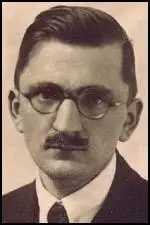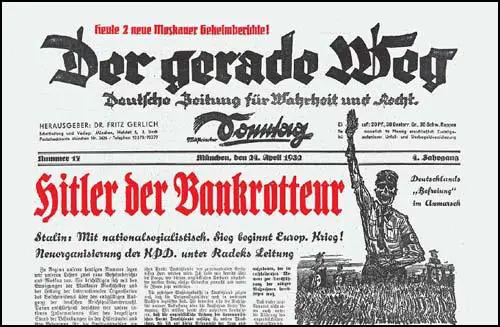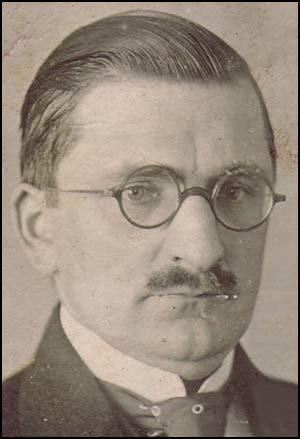Fritz Gerlich

Fritz Gerlich, the eldest of the three sons of wholesale and retail fishmonger Paul Gerlich and his wife Therese, was born in Stettin, Germany, on 15th February 1883. After attending the Marienstiftungymnasium, before arriving at the University of Munich in 1902.
Gerlich began studying natural sciences but shifted to history, receiving a doctorate for a dissertation on an eleventh-century Germanic emperor. After leaving university, Gerlich worked in the state archives. He held conservative views and published several anti-socialist articles in the right-wing press. (1)
As a result of his poor eyesight, Gerlich was unable to join the German Army during the First World War. He became a strong opponent of the Russian Revolution and in 1917 joined Alfred von Tirpitz, Wolfgang Kapp and Anton Drexler to form the German Fatherland Party. Gerlich published the book Communism as the Theory of the Thousand Year Reich (1919). In the book he denounced anti-Semitism, which he believed had grown worse because of the leading role that Jews had taken in the revolution.
Fritz Gerlich and Adolf Hitler
In 1920 Gerlich was appointed as editor in chief of the Münchner Neueste Nachrichten. Over the next couple of years he emerged as a respected and influential figure in the nationalist movement. In the spring of 1923 Gerlich had a meeting with Adolf Hitler. It is believed that at the meeting, Hitler gave his word of honour that he would support the right-wing Bavarian prime minister Gustav von Kahr and would not resort to illegal putschist methods. Gerlich was appalled by the Beer Hall Putsch on 8th November 1923. Gerlich wrote in his newspaper that it was "one of the greatest betrayals in German history". (2)
Gerlich left the Münchner Neueste Nachrichten after he was taken over by the reactionary nationalist, Alfred Hugenberg, who had started funding Hitler. In 1931, with the financial support of Prince Erich von Waldburg-Zeil, he began publishing a weekly political newspaper, Der Gerade Weg, that attacked the policies of the extreme right, National Socialist German Workers Party and the extreme left, German Communist Party (KPD). Gerlich advocated the restoration of the monarchy under Crown Prince Rupprecht.
In his newspaper, Gerlich predicted that if Hitler gained power it would lead to "enmity with neighbouring countries, internal totalitarianism, civil war, international war, lies, hatred, fratricide and infinite trouble." Ron Rosenbaum has pointed out that what makes Gerlich so unusual is that he was "an early, credulous supporter of the extreme nationalist politics Hitler represented" but he became the "most outspoken centre of anti-Hitler journalism on the conservative side of the political spectrum" in Germany. (3)
Death of Geli Raubal
On the morning of Saturday, 19th September, 1931, Geli Raubal, the niece of Adolf Hitler, was found on the floor of her room in the flat. She had been killed by a Walther 6.35 pistol that was owned by Hitler. Anti-Hitler newspapers, including Der Gerade Weg, suggested that Hitler had murdered Geli. According to the son of a man who worked for Gerlich, the newspaper got hold of a copy of "a state's attorney inquiry into the matter of Geli Raubal" that purportedly "showed that Geli was killed by order of Hitler."
Ronald Hayman, the author of Hitler & Geli (1997) has pointed out: "Seeing an opportunity to discredit Hitler, Gerlich used all his journalistic skills to investigate Geli's death. As his suspicions hardened, he collected evidence for publication in pamphlet form. If we can trust the summary of the pamphlet in The Memoirs of Bridget Hitler, he got affidavits from Willi Schmidt, the critic Geli had consulted about teachers in Vienna, and from one of the police inspectors who had visited the flat. This man - we do not know whether it was Sauer or Forster - believed that Hitler had been in the flat when the shot was fired.... Gerlich came to the conclusion that, instead of leaving for Nuremburg, Hitler had postponed his trip. Herr Zehnter, the owner of a Munich restaurant called the Bratwurstglockl, testified that Hitler arrived with Geli on the evening of Friday the 18th, that they were in a private room on the first floor till nearly one in the morning, and that Hitler, who rarely touched alcohol, was drinking beer. According to this summary of the pamphlet, he and Geli went back to the flat, where he threatened her with his revolver and shot her." (4)

It has been claimed by Ron Rosenbaum that Adolf Hitler was particularly upset by an article by Gerlich that appeared on 17th July 1932 in Der Gerade Weg, that had the headline, "Does Hitler have Mongolian Blood?". In his book, Explaining Hitler: The Search for the Origins of his Evil (1998), Rosenbaum argues: "It still has the power to shock: Adolf Hitler married to a black bride. More than six decades after this extraordinary photocomposite image of Hitler in top hat and wedding tails, arm in arm with a black bride in a scene of wedding-day bliss, appeared on the front page of one of Munich's leading newspapers, this mocking representation of Hitler - in a context of decapitation, miscegeneration, transgressive sex, and violent defacement - still gives off an aura of recklessness of danger." (5)
Adolf Hitler - Aryan or Mongolian?
In the article Gerlich uses Hitler's ridiculous "racial science" to prove Hitler was not Aryan but Mongolian. He takes a close look at Hitler's nose, which he describes as "Slavonic". The Slavic type, he points out, "was formed by the intermingling after the Hun invasion of Mongols with original Slav bloodstock." Gerlich goes on to argue: "The war-strategy of those times made it customary for the victorious armies to have sex with the woman and girls of the defeated peoples... We have to suppose that in the home region of Hitler's family foreign, no Nordic blood remained."
Gerlich then goes on to look at Hitler's political ideas: "Adolf Hitler explains that in his political movement there is only one will and that's his... He never has to explain what he does... his followers have to carry out his commands without any information... The contrast between the real Nordic ideal and the one of Hitler cannot be expressed any more dramatically. Hitler's attitude is absolutely un-Nordic and un-Germanic. It is, racially, pure Mongolian... It is Mongolian absolute despotism that is expressed in Hitler's attitude and that can be explained by the fact that this man is a typical bastard who has mainly non-Nordic blood in his veins." (6)

In a follow-up article the next week's edition of Der Gerade Weg, Gerlich argues: "We can't understand how people who call themselves righteous Catholics could feel upset by the juxtaposition of Hitler and a Negro woman. What exactly bothers you, dear ladies and gentlemen? Didn't you learn, in the first principles of our religion's catechism, not only that all men have their souls bestowed on them by God but also that we are all descendants of one father and one mother, children of Adam and Eve: According to our own Catholic principles, Negroes are our brothers and sisters even by blood, It is totally impossible for those of us with Catholic world views to 'degrade' a Central European like Adolf Hitler by pairing him with a Negro woman. A Negro woman isn't a person of inferior race.... We regard a Negro woman as our sister in blood." (7)
Arrest and Execution
On 9th March, 1933, Max Amann and Emil Maurice led a gang of stormtroopers into the Gerlich's offices, smashed all the machines and destroyed the contents of desks, files, cupboards and drawers, including the copy for the next issue of the newspaper. Ronald Hayman has suggested that the newspaper planned to carry articles on the death of Geli Raubal and on the Reichstag Fire. (8)
According to Ron Rosenbaum, the author of Explaining Hitler: The Search for the Origins of his Evil (1998): "The nature of the expose he'd been about to publish - some said it concerned the circumstances of the death of Hitler's half-niece Geli Raubal in his apartment, others said it concerned the truth about the February 1933 Reichstag fire or foreign funding of the Nazis - has been effectively lost to history." (9)
Fritz Gerlich was taken to Dachau where he was murdered on 30th June, 1934, the Night of the Long Knives. To notify his wife, they sent her his blood-spattered spectacles. Other Catholics murdered that day included Erich Klausener, the President of the Catholic Action movement and Adalbert Probst, national director of the Catholic Youth Sports Association. Richard Evans, the author of The Third Reich in Power (2005) has suggested that "Klausener's murder sent a clear message to Catholics that a revival of independent Catholic political activity would not be tolerated". (10)
Primary Sources
(1) Ronald Hayman, Hitler & Geli (1997)
Seeing an opportunity to discredit Hitler, Gerlich used all his journalistic skills to investigate Geli's death. As his suspicions hardened, he collected evidence for publication in pamphlet form. If we can trust the summary of the pamphlet in The Memoirs of Bridget Hitler, he got affidavits from Willi Schmidt, the critic Geli had consulted about teachers in Vienna, and from one of the police inspectors who had visited the flat. This man - we do not know whether it was Sauer or Forster - believed that Hitler had been in the flat when the shot was fired....
Gerlich came to the conclusion that, instead of leaving for Nuremburg, Hitler had postponed his trip. Herr Zehnter, the owner of a Munich restaurant called the Bratwurstglockl, testified that Hitler arrived with Geli on the evening of Friday the 18th, that they were in a private room on the first floor till nearly one in the morning, and that Hitler, who rarely touched alcohol, was drinking beer. According to this summary of the pamphlet, he and Geli went back to the flat, where he threatened her with his revolver and shot her.
(2) Fritz Gerlich, Der Gerade Weg (17th July, 1932)
Adolf Hitler explains that in his political movement there is only one will and that's his... He never has to explain what he does... his followers have to carry out his commands without any information... The contrast between the real Nordic ideal and the one of Hitler cannot be expressed any more dramatically. Hitler's attitude is absolutely un-Nordic and un-Germanic. It is, racially, pure Mongolian... It is Mongolian absolute despotism that is expressed in Hitler's attitude and that can be explained by the fact that this man is a typical bastard who has mainly non-Nordic blood in his veins.
(3) Fritz Gerlich, Der Gerade Weg (24th July, 1932)
We can't understand how people who call themselves righteous Catholics could feel upset by the juxtaposition of Hitler and a Negro woman. What exactly bothers you, dear ladies and gentlemen? Didn't you learn, in the first principles of our religion's catechism, not only that all men have their souls bestowed on them by God but also that we are all descendants of one father and one mother, children of Adam and Eve: According to our own Catholic principles, Negroes are our brothers and sisters even by blood, It is totally impossible for those of us with Catholic world views to "degrade" a Central European like Adolf Hitler by pairing him with a Negro woman. A Negro woman isn't a person of inferior race.... We regard a Negro woman as our sister in blood.
(4) Ronald Hayman, Hitler & Geli (1997)
Ignoring both the ban on opposition papers and the friends who advised him to stay away from his office, Gerlich obstinately went on preparing an issue of the Gerade Weg for publication on 12 March. The leading article was to accuse the Nazis of starting the Reichstag fire, to expose their secret plans for the annihilation of the Churches, to reveal Rohm's secret agreement with Deterding and to expose the facts that Gerlich had unearthed about Geli's death.
But on 9 March Max Amann and Emil Maurice led a gang of stormtroopers into the offices, smashed all the machines and destroyed the contents of desks, files, cupboards and drawers, including the copy for the next issue of the Gerade Weg. Amann, who as editor of the Volkischer Beobachter had often been vilified by Gerlich, punched him hard in the face, smashing his spectacles and injuring both eyes. The man who had danced with Geli at the carnival was almost blinding the man who eighteen months after her death was trying to champion her. But the irony would not have occurred to either of them.
Gerlich was imprisoned and later sent to Dachau, where he was killed during the Night of the Long Knives in June 1934. Georg Bell, after hiding on a rooftop, escaped to Austria, but the Nazis pursued him across the border, and on 3 April he was shot in his hotel bedroom.
Student Activities
Kristallnacht (Answer Commentary)
Adolf Hitler's Early Life (Answer Commentary)
Heinrich Himmler and the SS (Answer Commentary)
Trade Unions in Nazi Germany (Answer Commentary)
Adolf Hitler v John Heartfield (Answer Commentary)
Hitler's Volkswagen (The People's Car) (Answer Commentary)
Women in Nazi Germany (Answer Commentary)
German League of Girls (Answer Commentary)
References
(1) Ron Rosenbaum, Explaining Hitler: The Search for the Origins of his Evil (1998) page 160
(2) Ronald Hayman, Hitler & Geli (1997) page 184
(3) Ron Rosenbaum, Explaining Hitler: The Search for the Origins of his Evil (1998) page 160
(4) Ronald Hayman, Hitler & Geli (1997) page 185
(5) Ron Rosenbaum, Explaining Hitler: The Search for the Origins of his Evil (1998) pages 155-159
(6) Fritz Gerlich, Der Gerade Weg (17th July, 1932)
(7) Fritz Gerlich, Der Gerade Weg (24th July, 1932)
(8) Ronald Hayman, Hitler & Geli (1997) page 188
(9) Ron Rosenbaum, Explaining Hitler: The Search for the Origins of his Evil (1998) pages 155-159 xix
(10) Richard Evans, The Third Reich in Power (2005) page 34
